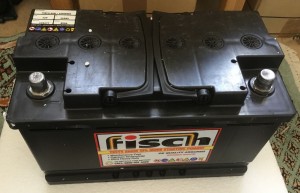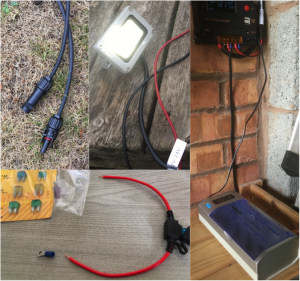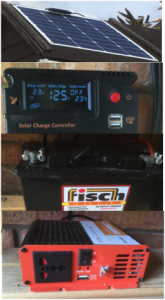“Off-grid eCharger”
The aim of this ‘off-grid’ solar energy project was to build a charger for an eBike so that its battery could be charged (when not in use) from power collected from the sun via a ‘fixed’ off-grid installation, rather than relying on mains energy. This can also be used for other battery charging and small backup supply purposes.
Four main elements were put together to create the solar charging ‘system’:
Solar PanelThis fundamental part performs the key task of converting sunlight into electrical energy. There is a wide range of panel types to choose between. Firstly, sizes include the very small, through 50W, 60W, 80W and up to 100W. Thereafter, systems are typically built from connecting multiple panels together.

Then, there are four main types of solar array:
a) Poly Crystalline – cheaper to manufacture, sensitive to high temperature, less efficient with a shorter lifespan
b) Mono Crystalline – more expensive, more efficient, with a longer lifespanc)
c) Thin-Film Amorphous (A-Si) – flexible, lower cost – easier to produce, shorter lifespan, lower power
d) Concentrated PV Cell (CVP) – very high performance, solar tracking and cooling required, very expensive.
Finally, there is the choice of construction type:
i) Rigid – cheapest and most solid, heavy and longest lasting
ii) Flexible – PET – light-weight and bendy, ideal for vehicles and temporary installations
iii) Flexible – ETFE – longer lasting, marine grade, can be walked on.
For this project, the aim was to use something lightweight that could be easily attached to an existing small building structure by means of the re-enforced ringlets in its corners (not all panels have these, so choosing had to be careful), rather than a permanent roof-top installation, and so the Flexible PET type was indicated.
After some consideration of likely ‘sun-hours’ – estimates tend to indicate an average of 2-3, depending on the season and weather – and also cost, a 50W 12V Mono Crystalline Flexible PET panel was selected. This size could prove to be an under-estimation for the task, but this can be supplemented later as necessary since its possible to join panels in parallel to increase current (or series, to increase voltage). That will require ‘T’ or ‘Y’ joining pieces for the MC-4 solar cable connectors, and potentially in-line fuses to protect separate ‘strings’ of connected panels (on their own they don’t need the fuses since their short-circuit current rating is sufficient).
If a panel becomes partly shaded, its whole output diminishes. Hence the advantage of having separate panels is that they may contribute more energy individually that using one large single panel. Another aspect is that it is likely that the cost of solar panels will reduce over time, and so adding to the system over time makes sense, rather than trying to ‘future proof’ the power requirement.
The task performed by this element is to ‘condition’ the output of the solar capture, converting an unregulated supply of around 18V (for a single panel) to a more stable 12V, the energy from which can be directly used or stored in the battery. The use of a controller avoids the risk of over-charging of the battery or issues with varying power, and will shut off its output to the loads when the supply is diminished and the battery is discharged. There are many models, which vary in power rating and functionality, some with simple LED displays and others showing a range of information, and may include sense terminals for long cable runs, temperature measurement for adjustment due to the weather and equalisation functionality for spreading charge across multi-battery systems.

The controllers fall into two main types:
a) PWM – Pulse Width Modulation
b) MPPT – Maximum Power Point Tracking
The latter of these is much more efficient, likely to convert more of the captured solar energy into stored power. However, these tend to be at least 3 times more expensive, often much more.
A modestly–priced (reasonably-functioned) PWM unit was selected for this system, with a 20A rating (more than enough for the initial project requirements). The reasoning for this product selection is this: with a small system, should the captured energy be not enough, then purchasing additional panel(s) to increased the wattage is more cost-effective in terms of energy produced, compared with the gain from the more efficient controller. It only becomes worth purchasing the MPPT version when much more energy is being generated (and therefore ’lost’ with a less efficient charge controller).The controller model selected is capable of both 12V and 24V operation, which allows for the increase the voltage rating of the system if desired in the future.
The traditional choice for this type of storage application is the ‘Lead-Acid Cell’, though it needs to be of a Deep-Cycle ‘Leisure’ variety, which is intended to be frequently discharged and recharged, rather than the ‘starting’ classification which is used in a vehicle for short-bursts of energy to get a motor running, after which its mainly in stand-by and therefore expected to be 100% charged most of the time.

Apart from this distinction, there are two main types of product:
a) ‘Flooded’ Wet-Cell or Valve Regulated Lead-Acid (VRLA)
b) Absorbed Glass Mat (AGM) or Gelled Electrolyte (Gel)
Of these, the Wet-Cell traditionally required periodic ‘maintenance’, topping up with fluid, though VRLA sealed versions are now available, and tend to ‘vent’ gas and can’t be tipped over due to the fluid inside. The AGM and Gel types however are available maintenance-free, don’t ‘vent’ gases and don’t have fluid that can spill out.
The AGM-type was selected for this project as, whilst being a bit more expensive, offered the convenience of a product shouldn’t require special attention; these are less sensitive to over-charging and can stand for 30 days totally discharged without harm.
There are a number of measurements of the capacity and capability of batteries:
- Reserve Capacity (RC) is how long the battery can deliver a constant current of 25A at 80F
- AmpHour (AH / C20) represents how much charge is stored. It is the energy delivered continuously in 20 hours at 80F without falling below 10.5V
- Cold Cranking Amps (CCA) is a measure of the ability to start an engine cold. It is the number of Amps delivered at 0F for 30sec by a 12V battery whilst maintaining at least 7.2 Volts
A capacity of 110AmH was chosen for this project. Whilst ‘the more the merrier’ in terms of storage is certainly the case, this capacity should be sufficient for the basic storage needs. It is advisable however to allow for discharge of only 50% of the stated rating, whilst also bearing in mind the possibility of a few days without sun.
It is possible to add batteries in Parallel to create more storage, or in Series to increase the voltage of the system. For a modest system set-up, 12V is sufficient and convenient for the purpose. Adding another battery to double the system voltage to 24V would have a side-benefit of requiring lower gauge of wiring.
In order to convert the 12V DC power generated from the Solar Panel and stored in the battery, to the 240V AC required by the Load, the Li-Ion battery charger adapter, an inverter is needed. This wouldn’t be the case if a suitable 12V charger-adapter could be sourced, which would avoid the inefficient ‘double-conversion’ of 12V DC into 240V AC and back into 42V DC again. The inverter does however provide the flexibility for powering other equipment requiring an AC ‘mains’ supply and therefore is ideal for a range of charging and backup tasks.

Apart from the selecting the correct voltage, which is normally either 12V or 24V (12V required to fit with this system set-up), there are two main choices:
a) Modified Sine-Wave
b) Pure Sine-Wave
The first type is the low-cost product, and available in a wide range of power-ratings, so if high-power is required then that tends to be the preferred choice. The draw-back is that it is less-efficient, creating a ‘blocky’ AC waveform which can upset sensitive equipment. The second type produces a smooth sinusoidal AC waveform equivalent to the standard AC ‘mains’ supply, and therefore is suitable for all equipment types, though at higher cost and usually lower-power rating.
Given the performance uncertainty and potential for harm to some equipment that the MSW product might bring, and the modest power needed, it seemed sensible to select the PSW variant. A 300W product was chosen, partly limited by cost, but also since it is recommended to ‘match’ the power rating to the consumption requirements; in practice the inverter size should be around 3-7 times the power needed by the load appliance. A much higher-than needed inverter is ultimately less efficient for smaller loads, consuming more power than necessary.
Additional parts required were cabling and mounting accessories, plus some optional ‘add-ons’ in the form of other battery chargers and lights to make full use of the generated power:
System accessories
- An extension cable to connect the solar panel to the solar controller. The panel itself comes with about 1m of ‘tails’, fitted with MC-4 connectors which are standard for solar equipment. A ‘male’ connector provides the positive supply, and a ‘female’ connector offers the return negative connection. Two cables are therefore required, with the appropriate MC-4 connectors at one end, and unterminated at the other to connect to the solar controller. A ‘top tip’ is to obtain a single fully-terminated extension cable of twice the required length, and cut the cable half-way. For this project, a 25m extension cable was sourced, which provided 12.5m as a sufficient length for both positive and negative connections once cut in half. Thickness of the cable is an important consideration, so that the rating is sufficient for the power of the system and the loss due to the length of the connection. For this installation, a 4mm2 (12AWG) cable was selected, suitable for up to around 15m and 23A, meeting the needs.
- Battery terminal leads
- Midi and Blade Fuses and holders for fusing of the output from the battery supply (40A) and protecting the input to the charger controller (15A). The inverter came with a 35A mini-blade input fuse.
- Lugs and wire for the Solar supply and DC power connections
- Fixing screws for the solar panel, and cable clips
- 12V Lamp with remote and motion sensor, providing a light powered by the solar energy for the indoor work area
- AA / AAA / C / D / PP3 battery charger, for supplementary battery charging requirements, fed from the 12V output from the charge controller (avoiding unnecessary 240V conversion)
The resultant assembly captures energy from the sun via the solar panel, ‘conditioned’ by the controller (to avoid over-charging or issues with varying power) and stored in the battery. Naturally, this can take place throughout the day when the sun shines, without the need for a load to be present. Then when required, the load can be supplied from the stored energy.
The inverter is utilised to supply a replacement AC feed to the specialised Li-ion charger required for the load battery, which can therefore be used as an ‘off-grid’ power source for other uses in place of a regular ‘mains’ supply.
Charging additional Li-ion or Ni-Cad batteries for other equipment can be also be facilitated using the 12V output to supply an appropriate battery charger, and as well as powering 12V LED lights for illumination of the work space.
Hopefully this project is of interest and of use to anyone contemplating establishing a solar energy system, with the aim of harvesting energy from the sun, a ‘free’ resource available to us all!
@YellowsBestLtd our mission is in “Keeping Customers Operational”. We’re always keen to enhance our range of #business services, widen our #enterprise infrastructure support and expand our mix of #sustainable solutions we offer for supply and maintenance of new and legacy #technologies and products for our customers.
Please help us understand what would be of interest to you by getting in touch to discuss your management services or solutions requirements, whether you’re implementing new systems or maintaining existing infrastructure to serve your operational business needs. We look forward to hearing from you.


